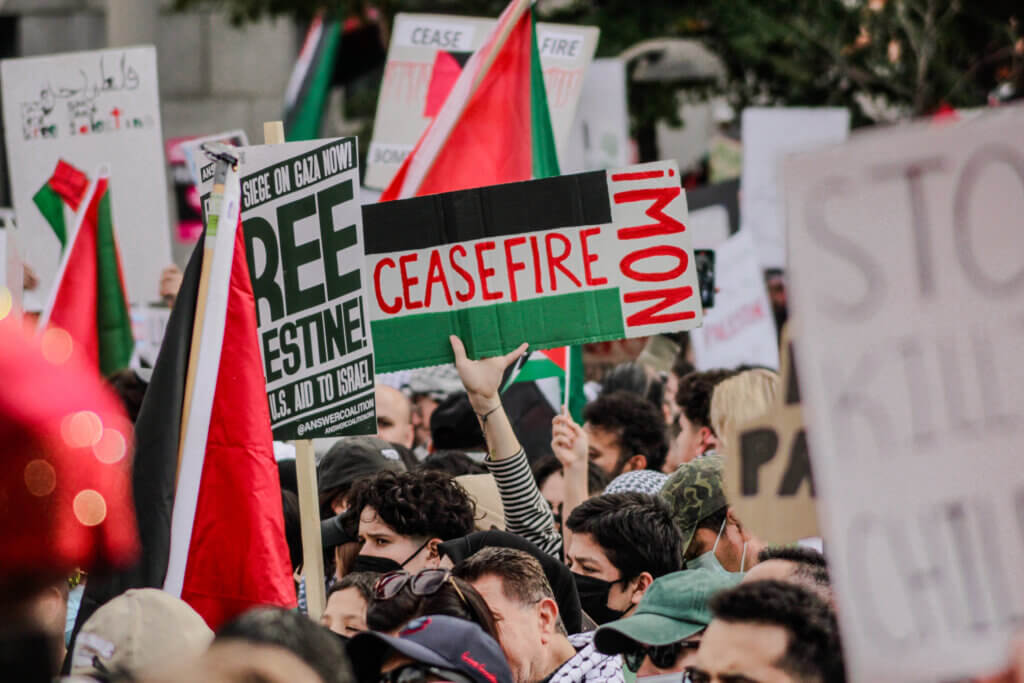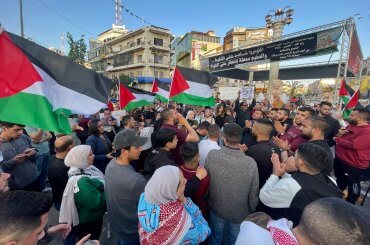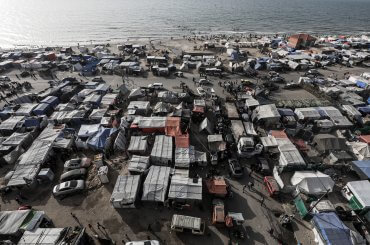Last month, the Illinois village of Bolingbrook passed a resolution calling for an immediate and permanent ceasefire in Gaza, making it the first Chicago suburb to adopt such a measure.
In a statement posted to Facebook after the resolution passed, Village Trustee Michael Carpanzano cited the local organizing that led to the measure.
“On a personal note, I have fielded literally hundreds of interactions on this topic especially in the past three weeks — both digitally (email, text, etc.) and in-person,” Carpanzano wrote. “Varying opinions and various suggested action items were discussed. Some will be grateful for last night’s action, others will not be. But know your message was heard, your voice was heard, your sentiment was felt.”
Reem Townsend is a Palestinian-American elected official in DuPage Township (where Bolingbrook is located) and a core organizer on the ceasefire resolution. She detailed some of the local organizing that Carpanzano referenced.
“I organized a Bolingbrook Families for Ceasefire under the organization Families for Ceasefire, a group co-founded by a Jewish anti-Zionist friend of mine,” she told Mondoweiss. “From that action, and social media posts on it, people reached out and wanted to know what more they could do. And so myself and friends of mine started a grassroots movement of pro-Palestine ceasefire actions in the western suburbs.”
“The local mosque has a good relationship with the village and they rallied people to show up to a strategy meeting where we discussed the resolution and created a chat group where we could share action items and next steps,” she continued. “We rallied people to call, email, schedule meetings with the rest of the board to emphasize the importance of a ceasefire resolution. At the meeting, we encouraged everyone to attend and speak about amending the resolution to call for a permanent ceasefire in Gaza. It passed unanimously because of months of local community organizing. Those relationships grew into a strong force for justice, as almost 200 people packed the room to express their support for a permanent ceasefire now.”
Bolingbrook is certainly not an outlier. Since Israel began its assault on Gaza last October, we’ve seen ceasefire resolutions passed across cities small and large, from Belfast, Maine to Seattle.
The Building Movement Project (BMP) and Muslims for Just Futures maintain a tracker that focuses on resolutions passed by local and state institutions across the United States. As of March 19th, 107 ceasefire resolutions have passed and another 33 have been proposed.
Deepa Iyer is the Director of Strategic Initiatives at BMP.
“As we continue to see the U.S. veto UN ceasefire resolutions, local municipalities send the message that the will of the people is moving in a particular direction,” Iyer told Mondoweiss. “Across the board, this not an easy road. There’s a lot of deep community mobilization, a lot of educating legislators.”
Muslims for Just Futures Executive Director Darakshan Raja was on the forefront of one such road in Chicago, which became the largest city to pass a ceasefire resolution in January. The tie-breaking vote was cast by Mayor Brandon Johnson.
“We used an inside and outside strategy,” said Raja. “There was a lot of work by Chicago progressive staffers calling on local city government to pass the resolution. We got 167 organizations to endorse it. The movement was multi-faith, multiracial. Chicago has largest Palestinian community in the entire country and Palestinian organizing were a huge part of it.”
City resolutions are part of a much larger protest movement calling for a ceasefire and its momentum has presumably pushed some politicians to back one. Nonetheless, the number of congress members calling for an end to the Israeli bombing remains low. 77 Senators and House Representatives have embraced the call, which is less than 15% of congress. Despite some public hand wringing, there’s also been no indication that President Biden is on the verge of forcing a ceasefire or cutting off military aid to Israel over the bombing.
However, the administration has to adapt to the movement and anxiety over Gaza impacting the presidential election is undoubtedly growing within The White House. Earlier this month NBC News reported that Biden’s handlers “taking extraordinary steps to minimize disruptions” from Palestine protests.
NBC also reported that Biden began “seething” at a private meeting after learning of his declining poll numbers in Michigan and Georgia, where “uncommitted” electoral efforts targeted the president in the states’ Democratic primaries.
Activists say the organizing happening now will have a lasting impact beyond the current moment.
“I see more civic engagement as a result of this point of entry,” explained Iyer. “We’re seeing more interest from communities of color who want to run for office, more interest in BDS. Stronger coalitions are being built.”
“We are seeing people make the connections between Israel and U.S. militarism, the connections to divestment, the connections to the training of U.S. law enforcement by the IDF. The connection between the foreign and domestic,” said Raja. “We’re able to talk about the war on terror, dollars being taken away from communities. Palestine is going to be one of those core social justice issues.”
“There’s going to be a shift,” predicts Townsend. “Social media has woken people up to where our tax dollars are going. We’re going to keep track of people who have called for ceasefire vs. those who stayed silent. More and more people are focusing on this, they’re focusing on holding our leaders accountable.”
While few national lawmakers have embraced calls for a ceasefire, polls show that there’s firm support for one among the U.S. public. A February Data for Progress poll found that 67% of likely U.S. voters support a ceasefire, including 77% of Democrats.
“People understand that the resolution is a baseline,” says Raja. “It’s not going to stop the genocide, but it’s helping to turn street power into political power.”



“People understand that the resolution is a baseline,” says Raja. “It’s not going to stop the genocide, but it’s helping to turn street power into political power.”
A major historical product of social activism in the US has been the almost predictable formation of networks and cells of like-minded, grassy-rooty people who persist and stay together, or at least in touch, to fight on for rights not necessarily connected to their original effort.
Women’s activism in the Abolitionist movement added great impetus to the emergence of the struggle for women’s rights including suffrage (Seneca Falls Convention (1848); Brown v. Board of Education (1954) and the arrest of Rosa Parks led directly to the historic March on Washington (1963) and the emergence of the Civil Rights Movement; The Student Struggle for Soviet Jewry (1964) emerged out of the growing concern for the plight of Soviet Jews; anti-war fervor in the late 1960’s led to the Moratorium to End the War in Vietnam (1969). Many of the people who cut their teeth in these actions went on to become influential academics, politicians, activists, educators, authors and journalists.
A common feature of all these social activist movements were the public demonstrations they inspired: the Moratorium was reported to have motivated half a million people to take to the streets. The March on Washington saw 300,000 people participate. Public marches and demonstrations are one of the most reliable and convincing metrics of public sentiment not only here in the US but worldwide.
So it is now with Palestine.
Millions upon millions of people in countries all around the world are marching, demonstrating, boycotting, calling for a ceasefire, blogging and demanding policy changes and more and better media coverage of the genocide taking place in Gaza.
One almost-immediate product of social incandescence is its destructive effect on entrenched in-group language-privilege and elite efforts to control the narrative. Calling for the abolition of slavery, the right of women to vote, the right to resist the draft, the right to equal opportunity, etc. were all radioactively taboo before their respective public demonstrations but that changed overnight once people cast off their inhibitions.
So it is now with Palestine.
Some examples of the brazen new outspokenness being voiced by graphic artists:
https://www.palestineposterproject.org/posters/why-fuck
https://www.palestineposterproject.org/posters/zionism-racism-fascism
https://www.palestineposterproject.org/posters/hey-israel
The effect of Israel’s current military action in Gaza may turn out to be as devastating for domestic American Zionism as the attack on Fort Sumter was for the American Slavocracy. Both actions unleashed forces the perpetrators understood not at all, or at the very least, very poorly.
View here more than 1,800 Gaza/Palestine solidarity posters created since October 7, 2023
“People understand that the resolution is a baseline,” says Raja. “It’s not going to stop the genocide, but it’s helping to turn street power into political power.”
Indeed. A major historical product of social activism in the US has been the almost predictable formation of networks and cells of like-minded people who persist and stay together or at least in touch to fight on for rights not connected to their original effort.
Women’s activism in the Abolitionist movement added great impetus to the emergence of the struggle for women’s rights including suffrage (Seneca Falls Convention (1848); Brown v. Board of Education (1954) and the arrest of Rosa Parks led directly to the historic March on Washington (1963) and the emergence of the Civil Rights Movement; The Student Struggle for Soviet Jewry (1964) emerged out of the growing concern for the plight of Soviet Jews; anti-Vietnam war fervor in the late 1960’s let to the Moratorium to End the War in Vietnam (1969). Every one of these movements introduced, trained and motivated a galaxy of academics, politicians, social activists and others whose experience and energies marked the decades after the events.
A common feature of all these social activist movements were the public demonstrations they inspired: the Moratorium war reported to have motivated half a million people to take to the streets.The March on Washington, 300,000. Public marches and demonstrations are one of the most reliable and convincing measures of deep public sentiment not only here in the US but worldwide in the modern era.
So it is now with Palestine. Millions of people in countries all around the world are marching, demonstrating, boycotting, calling for a ceasefire, blogging and demanding policy changes and more and better media coverage of the genocide taking place in Gaza.
One product of social incandescence is the destructive effect it has on in-group language-privilege and the elite effort to control the narrative and discourse. Calling publicly for the abolition of slavery, the right of women to vote, the right to oppose the draft, the right to equal opportunity, etc. were all taboo before these demonstrations but that changed overnight once the public no longer felt inhibited or feared repercussions.
So it is now with Palestine and the effect on political Zionism will, I assume, be as negative for the pro-Israel movement in the US as Abolition was for the American Slavocracy.
Abraham Lincoln constantly advised his Cabinet that “public opinion is everything”. Is Biden even looking out of the White House windows or viewing any YouTube videos?
View here more than 1,800 Gaza/Palestine solidarity posters created since October 7, 2023
Why are comments to this article closed?
Seems there are constant battles, few of which have liberation benefit in the long run.
How will Gaza’s schools get rebuilt with Sinwar in power? Can the WB achieve liberation with rocks or rifles?
Will there be a shift to politics, an election to decide on a consensus for a future?